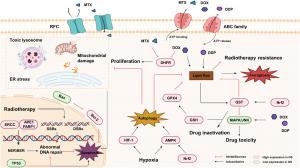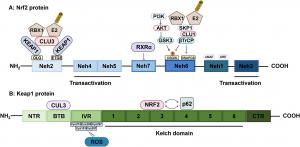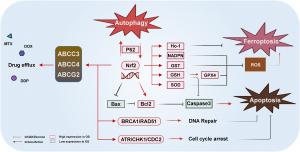Nrf2 Identified as a Key Driver of Treatment Resistance in Osteosarcoma

Mechanisms of resistance to chemoradiotherapy in osteosarcoma. In chemoradiotherapy resistant OS cells, altered expression of the drug transporter proteins, RFC and ABC family, reduces intracellular drug concentrations.
SHANNON, CLARE, IRELAND, April 20, 2025 /EINPresswire.com/ --
A deeper understanding of osteosarcoma, the most common primary malignant bone tumor affecting children and adolescents, is reshaping strategies for overcoming treatment resistance.
Central to this breakthrough is Nuclear factor E2-related factor 2 (Nrf2), a transcription factor now recognized as a pivotal player in chemoradiotherapy resistance. Traditionally acknowledged for its role in antioxidant defense and maintaining cellular homeostasis, Nrf2 emerges in recent insights as a double-edged molecule, offering protection in normal tissues but serving as a survival mechanism in malignant cells.
The overactivation of Nrf2 in cancer cells enables them to withstand oxidative stress, enhance DNA repair, evade apoptosis, and reduce intracellular drug concentration. These effects are achieved through the activation of the antioxidant response element (ARE), which upregulates enzymes involved in detoxification and drug efflux. As a result, osteosarcoma cells equipped with elevated Nrf2 expression exhibit multi-drug resistance, undermining the effectiveness of chemotherapeutic agents such as cisplatin, doxorubicin, and methotrexate.
Beyond drug resistance, Nrf2 contributes to radiotherapy resistance by mitigating the damage induced by reactive oxygen species and facilitating DNA double-strand break repair. Its interaction with pathways such as Keap1-Nrf2-ARE, PI3K/AKT, and autophagy networks highlights its extensive involvement in orchestrating cellular responses that defend tumor survival. The crosstalk between Nrf2 and regulated cell death mechanisms, including ferroptosis and autophagy, further underscores its centrality in osteosarcoma progression.
Notably, Nrf2 also supports tumor proliferation and metastasis by driving metabolic reprogramming and enabling epithelial-to-mesenchymal transition. Its elevated expression in osteosarcoma correlates negatively with patient survival, affirming its oncogenic potential. While therapeutic inhibition of Nrf2 remains challenging due to its protective role in normal tissues, preclinical approaches using agents like ML385 and natural compounds such as oridonin have shown promise in reversing resistance and reducing tumor burden.
This exploration into Nrf2’s multifaceted role marks a significant advancement in the quest to overcome treatment resistance in osteosarcoma. As research continues to unravel its regulatory mechanisms, Nrf2 is being spotlighted as a potential therapeutic target that could revolutionize future interventions for aggressive pediatric bone cancers.
# # # # #
Genes & Diseases publishes rigorously peer-reviewed and high quality original articles and authoritative reviews that focus on the molecular bases of human diseases. Emphasis is placed on hypothesis-driven, mechanistic studies relevant to pathogenesis and/or experimental therapeutics of human diseases. The journal has worldwide authorship, and a broad scope in basic and translational biomedical research of molecular biology, molecular genetics, and cell biology, including but not limited to cell proliferation and apoptosis, signal transduction, stem cell biology, developmental biology, gene regulation and epigenetics, cancer biology, immunity and infection, neuroscience, disease-specific animal models, gene and cell-based therapies, and regenerative medicine.
Scopus CiteScore: 7.3
Impact Factor: 6.9
# # # # # #
More information: https://www.keaipublishing.com/en/journals/genes-and-diseases/
Editorial Board: https://www.keaipublishing.com/en/journals/genes-and-diseases/editorial-board/
All issues and articles in press are available online in ScienceDirect (https://www.sciencedirect.com/journal/genes-and-diseases ).
Submissions to Genes & Disease may be made using Editorial Manager (https://www.editorialmanager.com/gendis/default.aspx ).
Print ISSN: 2352-4820
eISSN: 2352-3042
CN: 50-1221/R
Contact Us: editor@genesndiseases.com
X (formerly Twitter): @GenesNDiseases (https://x.com/GenesNDiseases )
# # # # # #
Reference
Xianglin Peng, Jing Feng, Han Yang, Ping Xia, Feifei Pu, Nrf2: A key regulator in chemoradiotherapy resistance of osteosarcoma, Genes & Diseases, Volume 12, Issue 4, 2025, 101335, https://doi.org/10.1016/j.gendis.2024.101335
Funding Information:
National Natural Science Foundation of China 82274559
Genes & Diseases Editorial Office
Genes & Diseases
+86 23 6571 4691
editor|genesndiseases.com| |editor|genesndiseases.com
Legal Disclaimer:
EIN Presswire provides this news content "as is" without warranty of any kind. We do not accept any responsibility or liability for the accuracy, content, images, videos, licenses, completeness, legality, or reliability of the information contained in this article. If you have any complaints or copyright issues related to this article, kindly contact the author above.
Foundry512 Expands Talent Roster, Hiring for Key Roles Across Media, Accounts, Projects, and Creative
Turner Home Team Expands Home Buying Services Statewide: We Buy Houses Across North Carolina fast for cash.
Sullivan’s Castle Island and Castle Island Brewing Co. Launch 'Rickey Business' Lager to Celebrate James Beard Award
Kalendarium
Więcej ważnych informacji
 Jedynka Newserii
Jedynka Newserii

 Jedynka Newserii
Jedynka Newserii

Prawo

KE proponuje nowy Fundusz Konkurencyjności. Ma pobudzić inwestycje w strategiczne dla Europy technologie
W środę 16 lipca Komisja Europejska przedstawiła projekt budżetu na lata 2028–2034. Jedna z propozycji zakłada utworzenie Europejskiego Funduszu Konkurencyjności o wartości ponad 400 mld euro, który ma pobudzić inwestycje w technologie strategiczne dla jednolitego rynku. Wśród wspieranych obszarów znalazła się obronność i przestrzeń kosmiczna. Na ten cel ma trafić ponad 130 mld euro, pięciokrotnie więcej niż do tej pory.
Firma
Były prezes PGE: OZE potrzebuje wsparcia magazynów energii. To temat traktowany po macoszemu

Choć udział odnawialnych źródeł energii w miksie energetycznym Polski jest stosunkowo wysoki i rośnie, to ten przyrost jest chaotyczny i nierównomiernie rozłożony miedzy technologiami – wskazuje Forum Energii. Dodatkowo OZE potrzebują wsparcia magazynów energii, a zdaniem Wojciecha Dąbrowskiego, prezesa Fundacji SET, ten temat jest traktowany po macoszemu. Brak magazynów powoduje, że produkcja energii z OZE jest tymczasowo wyłączana, co oznacza marnowanie potencjału tych źródeł.
Infrastruktura
Wzrost wynagrodzeń ekip budowlanych najmocniej wpływa na koszty budowy domu. Zainteresowanie inwestorów mimo to nieznacznie wzrasta

Budowa metra kwadratowego domu w Polsce kosztuje od 5,55 do 6 tys. zł w zależności od województwa – wynika z najnowszych analiz firmy Sekocenbud. Najdrożej jest w Warszawie, gdzie cena za metr kwadratowy domu przekroczyła już 6,2 tys. zł. Na przyrosty kosztów budowy domu wpływają zarówno drożejące materiały budowlane, jak i wyższe wynagrodzenia pracowników. Inwestorzy nie rezygnują jednak z budowy domów jednorodzinnych, co ma związek m.in. z wciąż wysokimi cenami mieszkań czy też obniżką stóp procentowych.
Partner serwisu
Szkolenia

Akademia Newserii
Akademia Newserii to projekt, w ramach którego najlepsi polscy dziennikarze biznesowi, giełdowi oraz lifestylowi, a także szkoleniowcy z wieloletnim doświadczeniem dzielą się swoją wiedzą nt. pracy z mediami.










.gif)

 |
| |
| |
|